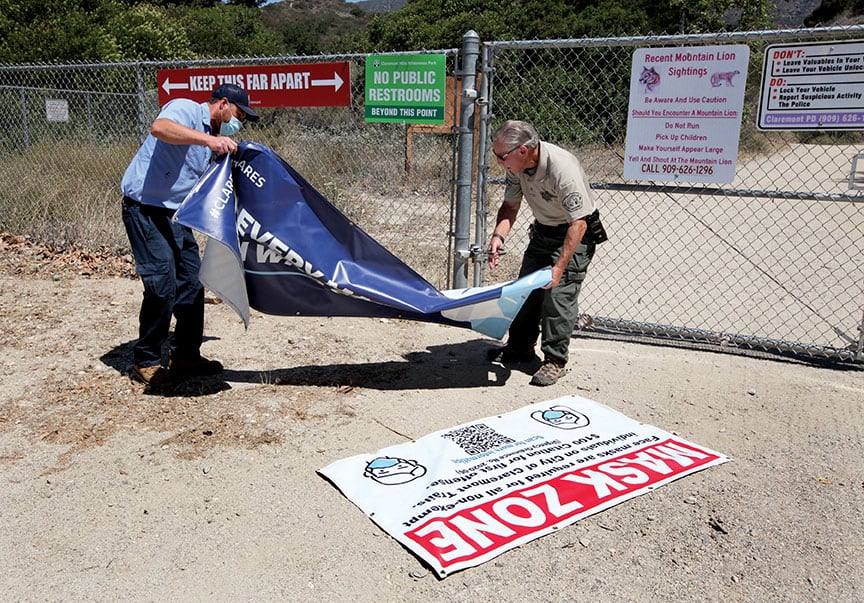COVID dominates the news, but city moves forward

City maintenance worker Rob Verboys and volunteer ranger Richard Weiner remove one of the COVID restriction informational banners on June14 at the Claremont Hills Wilderness Park. That week Claremont’s mask ordinance officially ended so visitors to the Wilderness Park, or the Claremont Village, no longer had to wear face coverings. That week was one of many times during the Pandemic that life seemed to be returning to normal. COURIER photo/Steven Felschundneff
by Steven Felschundneff | steven@claremont-courier.com
As we look back at the year 2021 it’s not surprising that the ongoing COVID-19 pandemic dominated the news. However, Claremont got back on its feet after a bruising 2020 and our city accomplished a number of long-term goals.
It was the first full year that the virus ruled our world, but in many significant ways it was not as scary as 2020. A year ago as I sat down to write the year in review, only healthcare workers and residents of nursing homes had access to the vaccine. Hospitals were full of very sick people and, as the new year approached, there were roughly 14,000 new cases and 225 deaths per day in Los Angeles County.
“On average, a person passes away every 15 minutes in L.A. County. We may be on our way to weekly death tolls of 1,000 or more,” Public Health Director Barbara Ferrer said during the first news briefing of 2021.
Here is a glimpse of the devastation wrought by SARS CoV-2 over the past year: on January 1, 2021 there were 828,783 cumulative cases and 12,144 deaths in the county. As of December 16, the county has recorded 1,553,366 cumulative cases and 27,388 deaths. Many of these cases and deaths occurred in January as the winter surge peaked, and in February as people continued to succumb to the virus.
In Claremont, COVID-19 numbers increased dramatically during last year’s holidays, with the county reporting 1,206 cumulative cases and 19 deaths on December 24, 2020 and 1,549 cases and 25 deaths eleven days later. As the year drew to a close, Claremont’s statistics had increased substantially to 3,163 cumulative cases and, tragically, 70 deaths.
Although people continue to become sick and die every day, the future does not look nearly as dire as it did 12 months ago because we have an effective and readily available vaccine. An impressive 69% of county residents age five and older are now fully vaccinated, a number that increases to 75% for those over 12. Meanwhile, 19% have received a booster.
This is important because as case and positivity rates have increased over the past couple of weeks, deaths have remained relatively low. Even with the threat of a new winter surge, (the county reported 3,730 new cases on December 18), the daily averages in L.A. County are far better than on last New Year’s Day when there were 20,414 new cases reported, a total of 7,613 people hospitalized and the test positivity rate was 21.6%. I sincerely hope when this story publishes in just under two weeks that the news about cases in the county is still good.
Looking back at a timeline of the pandemic, it’s startling to see how many times we thought we had this virus beat only to have it come back. Last June it really did seem like normal was right around the corner but then the Delta variant changed that calculus. Still, our local economy has struggled back to life as business owners and employees learn to navigate the pandemic. Most of us dutifully don our masks when entering a shop, illustrating a general sense of respect for our fellow citizens.
In a bit of surprising good news the city’s finance department reported a budget surplus due to conservative planning and better than expected sales tax revenue. Those extra funds were used to pay down part of the city’s CalPERS liability and to increase its emergency reserves.
Village South Specific Plan
Housing affordability and future development projects were by far the biggest non-COVID story of the past year and the most significant of these was the passage of the Village South Specific Plan.
The VSSP is a sprawling planning document which, when fully implemented, will alter the look and livability of Claremont forever. Passed by the city council last summer it rezones and creates a special development overlay in the largely industrial area south and east of the current Village. The specific plan calls for the construction of transit oriented developments which include mixed residential and commercial use along with higher density, multistory buildings and access to public transit.
Supporters lauded the plan for helping to create different types of housing from the city’s typical single family homes, and more affordable units as well. Critics condemned the size and scope of the proposed buildings saying it effectively urbanizes Claremont’s downtown. They also expressed concerns that the plan included inadequate parking and would increase traffic in the areas adjacent to the development.
In September the council updated and strengthened the Inclusionary Housing Ordinance to require any future development of five for sale units or more to include 10% for moderate income and 5% for low-income buyers. Similarly, any rental construction would have to include 10% for moderate and 5% for low-income earners.
The Inclusionary Housing Ordinance was initially tied to the passage of the Village South Specific Plan, but the council elected to decouple the two to avoid unintended consequences for the first development under VSSP, which will be called South Village. The decoupling decision resulted in considerable disappointment from affordable housing advocates.
Other development news
In May the city council upheld by a 3-2 vote the recommendation of two commissions not to approve a development at Foothill Boulevard and Monte Vista Avenue known as The Commons because the flight pattern of Cable Airport crosses the property.
In January construction began on the final phase of townhome development known as Colby Circle after years of delays.
Trumark Homes revised its plan to build single family homes on the former La Puerta school site after its request to annex a portion of the existing sports park met with general disapproval from the city and neighbors. The revised and scaled down plan may placate some of the city’s concerns but neighbors remain quite opposed. Look for much more on this in 2022 as it begins the commission process.
Reimaging school safety
Following the killing of George Floyd many cities, including Claremont, took a hard look at the way policing is conducted in the community. One reform took root in July when the city council voted to reimagine safety at Claremont public schools, which could include eliminating the city’s school resource officer.
Responding to the recommendations of a special police commission ad hoc committee, the council approved a motion that would redesign the program “provided that funding is available to ensure no loss of coverage, staff or police officer positions, that the city re-designate the school resource officer to a lateral designation within the police department with a secondary assignment to the Claremont Unified School District to respond to student/school related calls.”
A stakeholder working group of students, educators, parents and district employees was announced in December and will begin the work of designing a new program by the June 30, 2022 deadline set by the council.










0 Comments